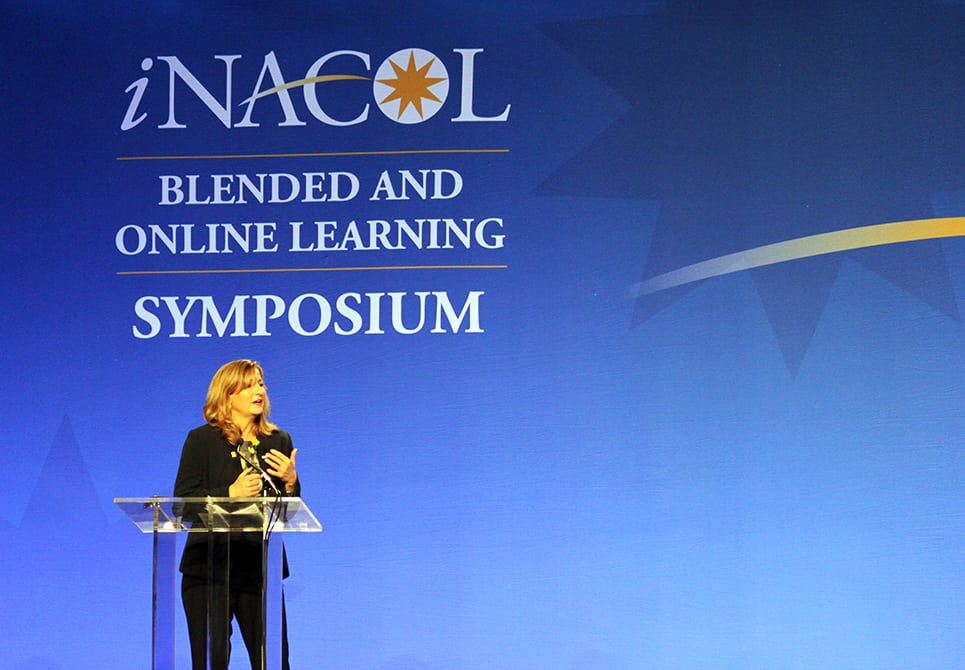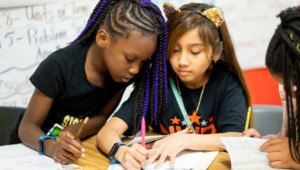The Many Ways Personalized Learning Plays out in Education

“Innovation” and “education” are two words often used in the same sentence. And while both words are near and dear to our hearts (and our work), we’ve noticed a key shift in the way people are talking about education innovation–a shift that represents the growing recognition of the potential of innovation in education to close achievement gaps, boost student access and better prepare learners for life beyond graduation.
Starting with iNACOL President and CEO Susan Patrick’s keynote at iNACOL’s 2015 Blended & Online Learning Symposium, the focus on innovation for equity framed much of the conversation across the an annual gathering of more than 3,000 educators and education leaders.
YES! Love the framing of "innovation for equity" in @susandpatrick opening keynote. It's going to be a great week! https://t.co/THVE0RmQgx
— Carri Schneider (@CarriSchneider) November 9, 2015
Eduardo Briceno’s keynote reinforced an emphasis on everyone’s ability to learn, the importance of growth mindsets to decrease achievement gaps and better prepare students for the workplace. (See Eduardo’s #SmartParents contribution on Growth Mindset Parenting)
Teach content, basic skills, higher-order competencies (deeper learning) & learning motivation, efficacy says @eduardobricen0 #inacol15
— Carri Schneider (@CarriSchneider) November 9, 2015
Blended + Personalized
Does blended learning work? Should I blend learning? And what should I measure to answer these questions? A debate featuring perspectives from The Learning Accelerator, Christensen Institution, Getting Smart and Jefferson Education Accelerator attempted to answer these three questions. The resounding conclusion across the panel, “It depends.” It depends on your goals for teaching and learning, the problems you’re trying to solve and the job you’re “hiring” technology to do. The panelists encouraged an approach to measuring outcomes that recognizes the role of traditional quantitative measures while simultaneously appreciating qualitative measures around student engagement, teacher satisfaction, parent involvement, school climate/culture. (See also The Blended Learning Implementation Guide 3.0 & TLA Blended Learning Research Clearinghouse.)
How to Create and Foster Learning Environments That Support GenDIY
Think of a non-traditional student that struggled, who took control of their own pathway, and through their challenges, found a unique pathway. Most likely, the young person you are thinking of was empowered to pursue their unique calling by personalized learning. At the core of Generation Do-It-Yourself are personalized learning opportunities, models and strategies.
So what are these new pathways?
- Anytime, anywhere learning opportunities
- Getting through high school: flex, GED, online, home, independent study, dual credit
- Rethinking College: early college, code schools, online options, micro-credentialing
- Learning on the Job: Internships, applying passion, matching skill + will
- Emerging Imperatives: Building a brand, populating a portfolio
- ReSchooling: Mentoring, advisory
What’s the role and responsibility of educators?
This question was explored in a session at the iNACOL Symposium where educators shared that in order to create learning experiences that support young learners they need to reimagine both their role as educators and the schools they teach in. Teachers shared that their role has to transform from content deliverer, to learning facilitator and opportunity identifier. The importance of advisory was echoed throughout. For schools, the idea that schools are the main location for learning for students is steadily changing as low-cost, effective platforms are allowing students to access content, anytime, anywhere.
The most important thing to support #GenDIY is an adult who cares @tvanderark @post_west @mickeyrevenaugh #inacol15 pic.twitter.com/xOJU6x2IFR
— Mary Ryerse (@maryryerse) November 9, 2015
Project-Based + Personalized
How do you leverage inquiry and passion to maximize learning? That question is at the heart of the “match made in heaven” between project-based and personalized learning. Tim Presiado and Kristin Cuiia of New Tech Network provided numerous examples of New Tech’s strategies to implement project-based learning in a way that leverages student interests. They distinguished between authentic personalized projects and following a recipe. As Tim stated, “It’s not a project if everyone creates the same thing – for example, if every student in the class creates the same mobile of the solar system, it’s a recipe.”
In contrast, with a project, the focus is on empowering students to be self-directed and to use inquiry throughout the process. The New Tech team also shared examples of how they support teachers in using assessment data to design learning experiences that simultaneously support project completion and address critical areas of improvement. They are using Agilix’s Buzz platform to customize instruction and assessment throughout their network.
.@newtechnetwork #PersonalizedPBL is match made in heaven. Parterning w/ @agilix to customize @tpresiado @kriscuilla pic.twitter.com/JmfjyP2bqq
— Getting Smart (@Getting_Smart) November 9, 2015
For more on iNACOL, check out



0 Comments
Leave a Comment
Your email address will not be published. All fields are required.